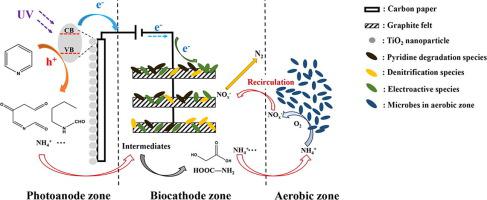Chemical Engineering Journal ( IF 13.3 ) Pub Date : 2021-09-22 , DOI: 10.1016/j.cej.2021.132598 Hefei Shi 1 , Dan Chen 1 , Xinbai Jiang 1 , Yan Li 1 , Wenbo Fan 1 , Cheng Hou 1 , Libin Zhang 2 , Yixuan Wang 3 , Yang Mu 3 , Jinyou Shen 1, 2

|
In this study, enhanced degradation of high-concentration pyridine and simultaneous denitrification were achieved in an Electricity assisted bio-photodegradation system (EBPS) with a photoanode zone, a biocathode zone and an aerobic zone. The recombination of photoelectron-hole pairs was significantly suppressed in EBPS, which could not only improve the pyridine oxidation in photoanode zone, but also accelerate the biodegradation process in biocathode zone. NH4+ produced from pyridine degradation could be effectively nitrified into NO2- and NO3- in aerobic zone, which was recirculated into biocathode zone to serve as electron acceptor for accelerating pyridine biodegradation. When influent pyridine concentration was as high as 1250 mg L-1, pyridine was completely degraded without adding any extra electron donors, and complete denitrification was achieved in biocathode zone. Microbial community analysis confirmed the enrichment of the pyridine biodegradation species (Rhodococcus, Hydrogenophaga, Truepera and Thermovirga), denitrification species (Thiobacillus, Thioalkalispira and Rhodococcus) and electroactive species (Thiobacillus, Thermovirga, Hydrogenophaga, Thioalkalispira and Rhodococcus). Furthermore, the mechanism of pyridine metabolism, denitrification and extracellular electron transfer processes in EBPS was investigated, utilizing Phylogenetic Investigation of Communities by Reconstruction of Unobserved States 2 (PICRUSt2). The results showed that the genes involved in pyridine degradation, denitrification and extracellular electron transfer were remarkably enriched in EBPS, indicating the crucial role of photoelectrical stimulation. This study provided a sustainable technical approach for simultaneous removal of pyridine and nitrogen in wastewater.
中文翻译:

在电辅助生物光降解系统中同时去除高浓度吡啶和反硝化
在这项研究中,在具有光阳极区、生物阴极区和好氧区的电辅助生物光降解系统 (EBPS) 中实现了高浓度吡啶的增强降解和同时反硝化。EBPS中光电子-空穴对的复合受到显着抑制,这不仅可以改善光阳极区的吡啶氧化,还可以加速生物阴极区的生物降解过程。吡啶降解产生的NH 4 +可有效硝化为NO 2 -和NO 3 -在好氧区,再循环到生物阴极区作为电子受体,加速吡啶生物降解。当进水吡啶浓度高达1250 mg L -1 时,吡啶完全降解,无需添加任何额外的电子供体,生物阴极区实现完全反硝化。微生物群落分析证实了吡啶生物降解物种(Rhodococcus、Hydrogenophaga、Truepera和Thermovirga)、反硝化物种(Thiobacillus、Thioalkalispira和Rhodococcus)和电活性物种(Thiobacillus,Thermovirga、Hydrogenophaga、Thioalkalispira和Rhodococcus )。此外,利用重建未观察状态 2 (PICRUSt2) 对群落进行系统发育调查,研究了 EBPS 中吡啶代谢、反硝化和细胞外电子转移过程的机制。结果表明,参与吡啶降解、反硝化和细胞外电子转移的基因在 EBPS 中显着富集,表明光电刺激的关键作用。该研究为同时去除废水中的吡啶和氮提供了一种可持续的技术方法。











































 京公网安备 11010802027423号
京公网安备 11010802027423号